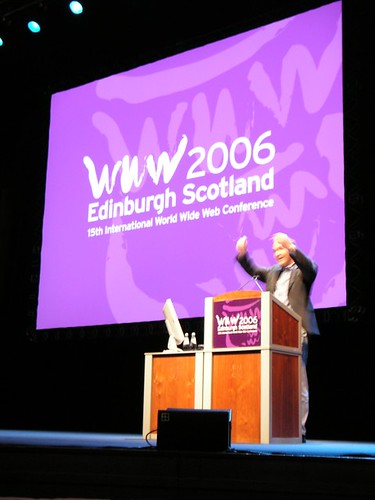2006-05-23
This week I will spend in Edinburgh where WWW2006 conference takes place this year. Here you can find some of my insights from the largest Web conference.
Our paper about Relaxed validator was accepted and given the fact that only 11 % of papers were accepted this year I persuaded our university to cover conference expenses for both me and Petr who actually wrote validator.
I must say that I quite like Edinburgh city. It is not really big, so it is quite easy to get almost everywhere by using your own foots. The most of buildings are made from stone which gives nice colors to the whole city.
WWW2006 is a quite big conference, there were about 1200 attendees if I heard that number correctly. Program was really extensive, usually ten parallel tracks which sometimes makes really hard to decide where to go, especially if you have quite broad interests as I have.
For me, the most interesting were presentations in Developers and W3C tracks. What was quite strange is that these tracks were situated in a quite small rooms which were always fully occupied. At the same time there were tracks for academic papers in much larger rooms which were almost empty.
It seemed to me that between speakers there are two different species. One are folks from W3C and member companies who were continuously talking about semantic web, RDF, OWL and all that stuff. My impression is that those people really believe in the semantic web and that they do not think that this is overengineered technology which is completely human unfriendly and never hit 80/20 rule. Even Tim Berners-Lee mentioned during some panel that everyone should provide RDF views of their data.
The second group of people can be characterized as Web 2.0 believers. Usually people from companies like Google, AOL, Yahoo or Technorati who need to solve some problems right now using currently available technologies in web browsers.
It seems that both groups respect each other. Semwebbers know that Web2.0ers have some code running, and viceversa Web2.0ers know that their solutions like microformats really can not scale. Hopefully both groups will converge. The result could be really usable semantic web, not that current crap[1].
Evening was vary pleasant. We spent several hours with Czech people from DERI discussing various Web issues while tasting several different kinds of beers.
[1] Quite strong statement. Sorry about that, it can hurt if you are semweb believer. But might be you could explain me two things which I consider as really showstoppers for RDF.
-
How to make statement about other already existing statement in RDF (this process is sometimes called reification)? Statements doesn't have identity in RDF, they are not referenceable and as far as I know you can not create statements about them directly. If you want to do so, you are forced to convert the statement to three supplement statements each of them is representing subject, predicate and object of the original statement. Such artificall RDF is then much harder to process and interpret because some statements are now not the first class RDF citizens.
-
How to know whether a subject identified by URI
http://www.kosek.czis me or my homepage?
Both of these problems are non-existing in Topic Maps. Moreover Topic Maps are much more close to 80/20 design rule then semantic web.

